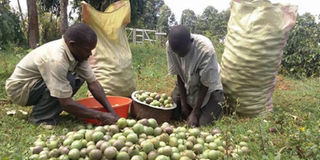Reaping from passion fruit growing

What you need to know:
- Keep watching for pests and diseases. According to Muhumuza, the most damaging disease is the passion fruit virus, which has no cure as it normally comes with the planting material.
- Additionally, for disease control, get an appropriate fungicide which must be applied to the leaves correctly, in terms of dosage.
Passion fruits, just like any other fruit, have its good and bad seasons, but when properly looked after, these fruits can enable a farmer generate significant income, writes Eseri Watsemwa.
Scientifically known as Passiflora edulis, passion fruits are not only beneficial in diets but also an avenue through which farmers earn an income. But how you grow and tend them will determine what you can get.
Passion fruits are a climbing vine, which grows fast.
In Uganda, there are two edible types of passion fruits grown - Passiflora edulis forma flavicarpa, the yellow or golden passion fruit, also known as the tropical passion fruit and Passiflora edulis, the purple type.
However, the purple passion fruits which are sweet, have high quality juice, with a good aroma and highly marketable compared to the yellow passion ones that are slightly bigger and more acidic.
Compared to the yellow passion fruits, the purple fruits are susceptible to diseases.
“Therefore farmers are encouraged to graft the yellow stalk with the purple one, being on top,” says Julius Peter Ahangaana, an agronomist and acting farm manager at Makerere University Agricultural Research Institute, Kabanyolo.
Ahangaana, who doubles as a passion fruit specialist and consultant, says if grafted, passion fruits mature faster and are stronger.
For proper passion fruit production, experts advise;
Site selection: Select an area whose soil is favourable for passion fruit growing. Site selection also involves soil testing and pest and disease survey, weather; light availability, temperature and water.
Seed selection: With passion fruits, according to John Bosco Muhumuza, research officer and crop etymology, Mbarara Zonal Agricultural Research and Development Institute, one has to take care of seed selection.
Muhumuza also cautions farmers against use of nets. “Nets accumulate a lot of moisture and make seedlings susceptible to disease. Instead, plant using wires lined towards the direction of the sun” he notes, adding that planting holes must be dug in a basin-like form to retain water.
Land preparation: Prepare the soil friable enough to allow root penetration and growth.
Select planting materials which are disease free and of appropriate variety, compatible with the area and soil.
Keep watching for pests and diseases. According to Muhumuza, the most damaging disease is the passion fruit virus, which has no cure as it normally comes with the planting material.
“Therefore, farmers should select virus free scions. Check to ensure the leaves are not mottled and the shoots are not stunted, which are typical signs of the virus,” he highlights.
Additionally, for disease control, get an appropriate fungicide which must be applied to the leaves correctly, in terms of dosage. Similarly, leaves with symptoms should be removed, buried or burnt.
Other practices for high passion fruit yields include;
• Buy scions from a trusted source. On average, a scion or graft costs Shs100 depending on availability.
• Applying fertilizers and well-rotten manure. This should be sequential.
•Practice pest and disease management and control.
•Train. It is important to train the vines on how to move on the wires.
•Prune adequately and timely by removing unproductive vines.
•Practice weed management.
•Ensure good aeration.
•Where appropriate, practice intercropping.
• During the dry season, passion fruit growers can apply a mulch.
•Farmers who grow passion fruits for commercial purposes should practice or incorporate drip irrigation.
Harvesting
During harvesting, Ahangaana recommends that farmers pick only ripe passion fruits which are not yet scorched. “Also, harvesting should be done using well aerated containers or baskets to avoid rotting and then grade and sort them,” he suggests.
By harvesting ripe passion fruits only, Muhumuza says there are higher chances of them staying fresh for a longer period of time.
Yields
If one uses approved purple passion fruits, he or she will harvest five tons per acre per season or year. “Yellow passion fruits on the other hand yield an amount of nine tons per acre per year,” notes Ahangaana.
On the market, a bag or sack of passion fruit, that weighs 100kg, costs between Shs200,000 and Shs400,000, depending on the season.
All in all, incorporating climate smart farming practices such as those discussed by experts is one way farmers can smile their way to the bank or better still reap big in passion fruit growing. All the above and much more will be practically demonstrated.
Capacity
In one acre a farmer may grow 500 to 600 seedlings/plants (averagely 550) depending on the variety and fertility of the soil and each plant if well managed can produce between 20 to 25 kilogrammes per season and each kilogramme sells at an average of Shs2,500 in most markets. Using an average of 550 (plants) x 20 kg x 2000 (considerably lower price) gives rise to Shs22m.
Given that in a year there are at least two seasons in most parts of Uganda, a farmer has a capacity of producing up to Shs44m. However this comes with a caution that appropriate agronomy is followed along with time management.More incomes are realised if the farmer adds some value and improves on the marketing strategies and approaches of this product.




